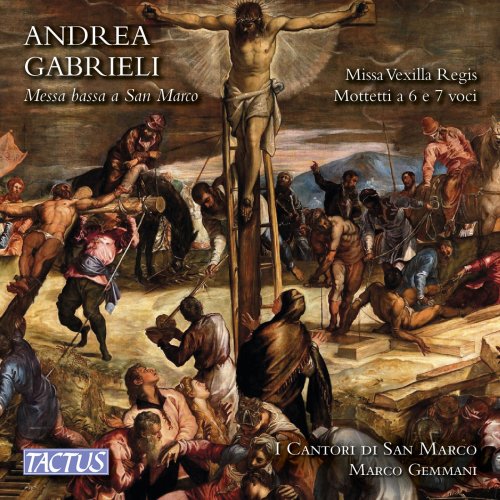
I Cantori di San Marco, Marco Gemmani - A. Gabrieli: Missa vexilla regis & Motets (2015)
BAND/ARTIST: I Cantori di San Marco, Marco Gemmani
- Title: A. Gabrieli: Missa vexilla regis & Motets
- Year Of Release: 2015
- Label: Tactus
- Genre: Classical
- Quality: FLAC (tracks + booklet)
- Total Time: 1:11:21
- Total Size: 363 MB
- WebSite: Album Preview
Tracklist:
01. Maria Magdalenae, et altera Maria
02. Maria stabat ad monumentum
03. Angelus Domini descendit
04. Hodie Christus natus est
05. Angelus ad pastores ait
06. Eructavit cor meum
07. Isti sunt triumphatores
08. Beatus vir qui non abiit
09. Iniquos odio habui
10. Domine Deus meus
11. Emendemus in melius
12. Iudica me Deus
13. O fili Dei, succurre miseris "Sancta Maria, succurre miseris"
14. O gloriosa Domina (O gloriose Domine)
15. Kyrie
16. Gloria
17. Credo
18. Sanctus
19. Benedictus
20. Agnus Dei
01. Maria Magdalenae, et altera Maria
02. Maria stabat ad monumentum
03. Angelus Domini descendit
04. Hodie Christus natus est
05. Angelus ad pastores ait
06. Eructavit cor meum
07. Isti sunt triumphatores
08. Beatus vir qui non abiit
09. Iniquos odio habui
10. Domine Deus meus
11. Emendemus in melius
12. Iudica me Deus
13. O fili Dei, succurre miseris "Sancta Maria, succurre miseris"
14. O gloriosa Domina (O gloriose Domine)
15. Kyrie
16. Gloria
17. Credo
18. Sanctus
19. Benedictus
20. Agnus Dei
While during most of the sixteenth century vocal polyphonic music had steadily focused on a four-part structure, around the fifteen-seventies the number of parts underwent a remarkable increase, particularly in sacred music, all over Italy. In 1560 a six-part composition was still regarded as an unusual piece for special occasions, but in 1580 this number of parts was considered not very high, since in the most important festivities, music formed of eight or more parts was performed, and, particularly in Venice at the end of the century, pieces formed of no less than twenty or more parts were composed. A typical example of this case is the Concerti published by Giovanni Gabrieli in 1587, one of the cornerstone works of the musical production of the second half of the sixteenth century: many Italian and foreign composers admitted that they had obtained new ideas from this work, where the six- and seven-part pieces appeared to be the most “simple” ones, while the ten-, twelve- and sixteen-part pieces were predominant. The four-part structure, which had been customary up to a few years before, seemed to be obsolete by then. The structure of these polyvocal, often also polychoral, pieces, is not particularly complex. Their appeal consists chiefly in the pursuit of grandeur, the dynamic play of the choral masses, the restless rhythm of the sequences of chords, and the search for a sound that is rich in harmonics. We cannot be sure, on the contrary, of the liturgical use of the six- and seven- part motets contained in this collection…
As a ISRA.CLOUD's PREMIUM member you will have the following benefits:
- Unlimited high speed downloads
- Download directly without waiting time
- Unlimited parallel downloads
- Support for download accelerators
- No advertising
- Resume broken downloads


